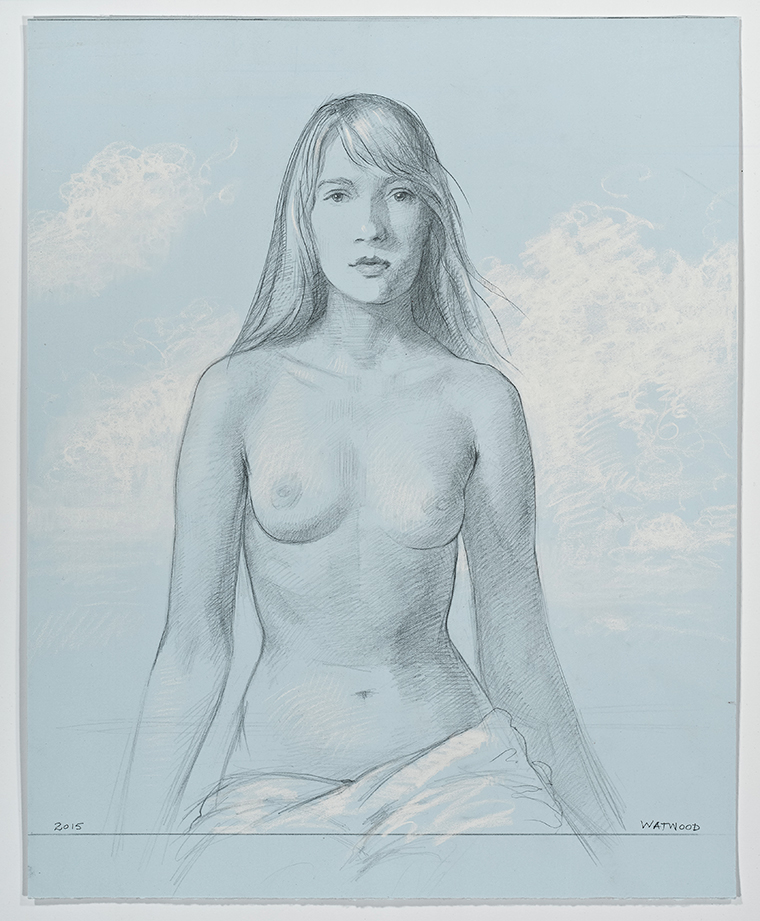Masterful figurative artists such as Patricia Watwood are in such a unique position because — perhaps better than any other subject — the human body can communicate a multitude of deeply moving and fundamental themes. How and why does she do it? Find out here.
The list of world-class faculty members who will be included in the first ever Figurative Art Convention & Expo, to be held November 8-11, 2017 in Miami, continues to grow. Organizers couldn’t be more excited that one of them is New York-based painter Patricia Watwood. In addition to having developed mastery with her technique, Watwood explores transformative narratives, mythological archetypes, and the human condition in her paintings, which have continued to intrigue collectors, connoisseurs, and galleries for years.

Although Watwood’s most common subject matter includes female nudes, each painting begins with a theme or narrative that interests or inspires the artist. That theme is then developed through small sketches. “A pictorial theme sticks with me when I find ways in which it has connections with my own preoccupations or societal issues — the painting has multiple levels of operation,” Watwood says. “Certain images just pop into my head as a composition. I have developed a practice of making small thumbnails of these ideas (or even just a written description if I can’t sketch), so that I can get them down when I catch them.

“Lately these are small pencil and watercolor sketches that record the inspiration. I don’t allow myself to judge — it’s just a tiny little piece of paper with some color. There’s nothing at stake, and, in this way, I can allow myself to at least explore any pictorial idea that comes and try to catch inspiration before it drifts away.”


One of the artist’s current projects — a painting of Suzannah and the Elders — typifies her incredible process. Watwood writes, “This painting actually started with a figure drawing that I made and loved the pose. I added a little composition to the drawing that became an idea firmly lodged in my head. The theme is about ‘forbidden images’ — the two elders spy on the beautiful Suzannah while she’s bathing in the moonlight. Lust, voyeurism, permission, desire, beauty, power — all these thoughts circle around this image for me — which I find very interesting from a feminist point of view as a female artist who paints beautiful women.
“So, with a drawing and a theme that intrigued me, it seemed destined to become a painting. However, then the drawing sat around for a long while waiting for me to get back to it while I finished other things. Finally, I started the painting a year ago, and worked for a while on the main figure. After another long pause, I’ve finally resolved the background, which is a dark nocturnal moonlit scene. It was completely unfamiliar territory, so it was slow pulling it out of the murk. I find I can proceed with quick confidence in areas that I’m familiar with — but whenever I work on some new challenge, it can be slow going.”

Narratives such as “forbidden images” or feminism and mythology are extremely important elements in Watwood’s painting. “In fact,” she adds, “if there isn’t some narrative in the painting, then I’m usually not interested in developing it. Occasionally, I make a painting ‘just because it’s pretty’ or for other formal painterly reasons, but I usually want my paintings to work on several levels — the first being aesthetic and pictorial, and the second being narrative and philosophic. I think narratives communicate in a very interesting way with viewers — like a novel or poem that can be read and unraveled. I’m interested in this level of communication, in addition to the visual aesthetic language.”
All told, Watwood seeks to spark connection between people and places in her paintings, “giving my audience a sense of the soul — in themselves and in the art,” she continues. “I hope they see a sense of the power and sacredness of the body and understand it to be in themselves as well.”

Naturally, and as alluded to above, the human figure is perfectly suited to Watwood’s conceptual and aesthetic goals. “At heart, my interest in the figure is all about my search for meaning in life in general,” she says. “My worldview tells me that we are spiritual beings having a human experience — a beautiful, terrible, wonderful human experience. The poignancy of our human condition seems to be the most interesting thing in the world to me. You could say that I’m trying to create documentary proof of the soul.”

Can’t you see why we’re so excited to have her as faculty at FACE2017? In November, Watwood will be teaching as a studio mentor, guiding attendees through making figurative paintings from a model. Through these sessions, Watwood will be painting as well, sharing her techniques and approach. She will also be taking part in a panel discussion on figurative art in which she will share her passion for how artists develop creativity and complexity in figurative painting. “I’ll share my perspective and insights from my 20 years in the field in New York City,” she says. “I think folks should attend because the conference is uniquely focused on the development of excellence in figurative art. If you are interested in participating in and having a career in this field, there’s nothing like FACE.”
To learn more about FACE and to register, visit the Figurative Art Convention & Expo. Learn more about the artist by visiting Patricia Watwood.
This article was featured in Fine Art Today, a weekly e-newsletter from Fine Art Connoisseur magazine. To start receiving Fine Art Today for free, click here.








